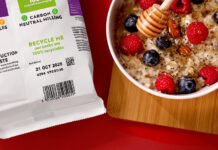Matt Perkins, Snack Foods Industry Marketing Manager at Videojet Technologies offers his views on industry trends, coding, and how to prevent coding errors in the salty snack industry
• What are the recent developments in the salty snack industry?
As today’s consumers seek convenience and variety, the salty snacks industry is subject to rapid changes. Manufacturers must innovate and constantly come up with new products, new flavours, new packaging types and in different sizes. Today’s consumers are more health aware and demand a wider choice of snacks. This trend is reflected in the Mintel US forecast volume growth projections (2014/2015) which predicts that the potato chips segment is expected to show a modest 1 percent increase, while the nuts category is expected to grow to 2.49 percent. This could be attributed to the fact that, as consumers are becoming more health conscious they switch to different snacks such as nuts which provide an excellent source of protein, dietary fibre and vitamin E and are considered healthier.
• What are the challenges faced by manufacturers in this industry?
The market is competitive and fragmented with many industry players, large and small. The importance of code quality in the salty snacks industry is higher for brand-focused companies as poor code quality can detract from the overall package and brand. However, the nature of this industry means that high quality coding can be a challenge. Grease, salt, dust and other environmental conditions can affect code adhesion and lead to poor quality printing. As packaging formats and materials are becoming more innovative and diverse, it is imperative to choose the right type of ribbon or ink to help ensure the highest level of quality marking.
Maintaining a high quality code is important to protect brand image and help ensure product traceability, but irrelevant if the code is not right. Ensuring that the correct code is applied in the correct location and on the correct product is essential. It will minimise the risk of costly product recalls, and reduce costs from product rework. However new products, new flavours and more bag sizes means more codes to manage and the potential for costly coding errors. In addition, codes have a tendency to be very similar, which makes it easy to get them confused.
• How can coding and marking solutions help manufacturers in the salty snacks industry address these concerns?
Thermal Transfer Overprinting (TTO) technology is particularly adapted to the sector as it has been engineered to print on flexible films such as bags and pouches used in the salty snacks industry. TTO offers high resolution coding of 300dpi for near letter quality codes. We have carried out our own research on Fast Moving Consumer Goods (FMCG), which include salty snacks, and have seen that up to 70 percent of coding errors are caused by humans. To address this problem, our TTO printers are equipped with code assurance solutions, which virtually eliminate coding errors and allow manufacturers to remove human errors from the message setup process, helping them meet the requirements of retail and regulatory guidelines for accuracy and product traceability.
Selecting a TTO solution also includes choosing the right ribbon. Not all ribbons are created equal. To understand the factors that affect code adhesion, suppliers have developed an advanced portfolio of high-quality TTO ribbons, and their expertise can help you get the most from your TTO printer. With variations engineered for optimal substrate adhesion in a wide selection of colors, snack producers are virtually guaranteed to find a perfect match for their application, packaging type and brand image.
• What other advantages have printing and coding solutions for the salty snacks industry?
Some snack producers now use laser marking systems to code on their products. A laser etches permanent codes with limited consumables and no solvents on select packaging materials. Also, in a manufacturing environment where eliminating downtime is critical, laser systems are relatively low in maintenance, with a typical month of production requiring few maintenance interventions, if any. For example, filters for the fume extractors must be replaced occasionally and waste residue from markings should also be wiped away from the laser lens periodically. Since lasers cannot work on all packaging materials, we would always recommend that manufacturers ask their coding suppliers for sample testing to assess the suitability of the technology for their particular application.












